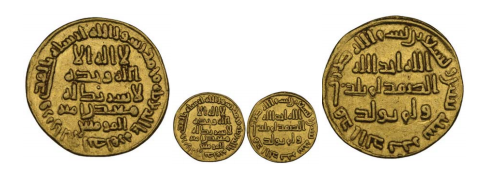
PREV ARTICLE
NEXT ARTICLE
FULL ISSUE
PREV FULL ISSUE
MORTON & EDEN OFFER RARE UMAYYAD GOLD DINAR
This press release from Morton & Eden discusses a rare Islamic gold coin being offered in the firm's October 20, 2016 London sale.
-Editor

One of the rarest and most sought after gold coins of the Islamic world is to be auctioned by specialist auctioneers Morton & Eden in London on Thursday October 20, 2016, when it is estimated to fetch up to £300,000. More than 1,300 years old, this pure gold ‘dinar’ is a little smaller than a UK one-pound coin, measuring approximately 20mm in diameter and weighing 4.25 grams. The dinar was issued when the whole Islamic world was controlled by the Umayyad dynasty. It was struck under the caliph al-Walid I in the Islamic year 92h, which equates to AD 711. At its zenith, the Umayyads controlled the fifth largest empire known to history, both in area and proportion of the world’s population, stretching from Spain to Northern India. What makes this coin so rare and desirable is the fact that the gold from which it was made appears to have come from a mine owned by the Caliph himself. Islamic coin specialist Stephen Lloyd of Morton and Eden explains: “As with all Umayyad dinars, most of the inscriptions on this coin come from the Holy Qur‘an. But this one is one of a very few known which bear two additional lines reading Ma’din Amir al-Mu’minin, literally ‘Mine of the Commander of the Faithful’, which was the title held by the Caliph. “The Caliph was all-important. As the successor to the Prophet Muhammad, he was the supreme religious and political leader of the Islamic state. “It is this direct link to the Caliph which, combined with its age and rarity, makes this dinar so significant. Coins with this special inscription were only ever struck in extremely small quantities - we know that the die for the obverse which bears the additional all important lines of provenance was used so sparingly that it survived for about four years. These dinars represent one of the greatest prizes to which any collector of early Islamic coins can aspire.” Coins with this intriguing legend are only known to have been struck in 89h, 91h, 92h (as here) and 105h, the latter bearing the additional inscription bi’l-Hijaz. Gold is still mined in this region, located within the present-day Kingdom of Saudi Arabia, and this gives a strong hint that the gold used in this coin may have come from a similar source – if so, these would be the first Islamic coins with links to the Kingdom. There is even an on-going debate among scholars as to whether there might be a connection between these coins and the Hajj pilgrimage. Regardless, these dinars remain among the most sought-after of all early Islamic coins. Most of the other known coins of these dates are held in private collections or major international museums, including the British Museum, the Bibliothèque Nationale in Paris, and the National Museum of Qatar. Illustrative of how rare they are is the fact that only two other dinars of this type and date have been sold at auction before, one at Morton & Eden in 2011 when it fetched a hammer price of £540,000, the other at an auction in 1999 when the price was £280,000. To read the complete catalog (this coin is lot 17), see:
Wayne Homren, Editor The Numismatic Bibliomania Society is a non-profit organization promoting numismatic literature. See our web site at coinbooks.org. To submit items for publication in The E-Sylum, write to the Editor at this address: whomren@gmail.com To subscribe go to: https://my.binhost.com/lists/listinfo/esylum All Rights Reserved. NBS Home Page Contact the NBS webmaster 
|